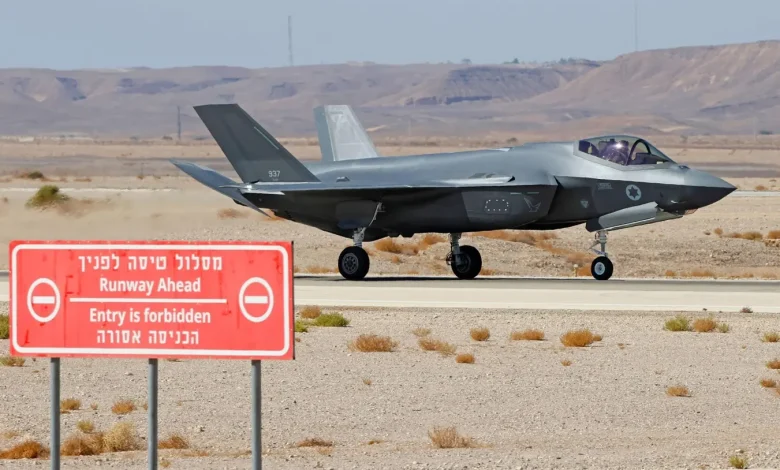Israel’s F-35 And Stealth Fighter Monopoly In Middle East May Soon End

An Israeli air force F-35 fighter lands during the “Blue Flag” multinational air defence exercise at the Ovda air force base, north of the Israeli city of Eilat, on October 24, 2021. (Photo by JACK GUEZ/AFP via Getty Images)
AFP via Getty Images
Almost a decade has passed since Israel received its first Lockheed Martin F-35 Lightning II stealth strike fighter from the United States. The fifth-generation aircraft markedly enhanced Israel’s air superiority and technological edge over the wider region, as demonstrated by recent wars, especially the 12-day June war against Iran. With the U.S. signaling its intent to sell F-35s to other regional states, this may prove the beginning of the end for Israel’s regional monopoly on F-35s and stealth aircraft in general.
President Donald Trump expressed his desire to sell Saudi Arabia F-35s during Crown Prince Mohammed bin Salman’s Nov. 18 visit to Washington, which not-so-subtly featured an F-35 flyover. Trump insisted that the U.S. would not supply Saudi Arabia with an F-35 inferior to the F-35s it provides Israel.
Amidst questions over the preservation of Israel’s qualitative military edge over the region, the Israeli government stated it expects continued access to more advanced American weaponry than other regional countries, which will almost certainly prove to remain the case.
Military analysts have already explained that the U.S. can simply supply Saudi Arabia with existing standard model F-35As, flown by the U.S. Air Force and most foreign F-35 operators, without including the substantial Block 4 upgrade from the present Technology Refresh 3. That would still give the kingdom an enormous technological air power advantage over Iran while simultaneously preserving Israel’s qualitative military edge.
Either way, it’s worth bearing in mind that Israel’s unique F-35I Adir variant already boasts more advanced Israeli sensors and systems than the standard F-35A. Israel is the only foreign country allowed to modify its F-35s, making them unique and, in many ways, incomparable to other F-35s, including those flown by the U.S.
Israel has a long history of modifying and improving American military equipment. For example, as the Foreign Policy Research Institute noted in a recent analysis, Israel has modified its older American-made AIM-9M Sidewinder air-to-air missile, making them effective against modern-day drone threats. To date, it hasn’t shared this modified version with Washington. Israel has undoubtedly made substantial modifications to its F-35Is that it hasn’t shared with anyone. So, even if Trump wanted to supply the Saudis with F-35s equally capable to the F-35Is, he probably couldn’t.
Then there’s the likely delivery time. Saudi Arabia probably won’t receive its first F-35A for at least 7-10 years. And that’s if a deal is concluded soon and isn’t suspended for political reasons, as happened with previously agreed-upon export deals to the United Arab Emirates and Turkey.
The UAE had secured an agreement for 50 F-35As at the end of Trump’s first term. However, Abu Dhabi suspended it by the end of 2021 over frustration with Washington’s preconditions. On the other hand, Turkey was suspended by the U.S. in 2019 after it ignored repeated warnings from Washington and pushed ahead with its acquisition of S-400 air defense missile systems from Russia. Ankara had hoped to acquire 100 F-35As to keep its air force up to date.
While Abu Dhabi has denied having any interest in reviving its F-35 deal, Ankara hopes the incumbent Trump administration will allow it to rejoin the program and buy at least 40 F-35As. Turkey needs these stealth jets to prevent its air force from becoming obsolescent and to keep up with rival Greece’s rapid fighter acquisitions over the past few years. Trump suggested he might approve such a sale during Turkish President Recep Tayyip Erdogan’s visit to the White House in September if Ankara cuts its purchases of Russian oil and gas.
Interestingly, even without F-35 acquisitions, Turkey and the UAE could begin operating stealth fighters within the next decade.
During the same week Trump said he favored a Saudi F-35 deal, Bloomberg reported that South Korea was pursuing $15 billion in weapons contracts with the UAE. News of the proposed package coincided with Korea Aerospace Industries’ showcase of its upcoming KF-21 Boramae fighter jet at the Dubai Air Show last week. Abu Dhabi reportedly showed interest in becoming a partner in the program developing that stealth combat aircraft as far back as 2023, as covered in this space at the time. More recently, as Bloomberg noted, officials from the Emirati air force toured KAI’s manufacturing facilities in April and an Emirati commander even participated in a test flight of a KF-21 prototype. Therefore, it’s conceivable that the UAE may eventually locally co-produce components of the Boramae and possibly acquire some for its air force.
At the same time, Turkey isn’t solely counting on an F-35 acquisition to equip its air force with fifth-generation jets. It’s presently developing its indigenous TF Kaan stealth jet. Ankara intends the Kaan to fulfil its air force’s requirement for stealth fighters and offer it for export. Turkey hopes the Kaan will enter service by the end of the decade, a similar timetable to South Korea’s for the KF-21.
While both combat aircraft are technically stealth fighters, the initial batches in both cases will have severe limitations in this regard compared to the F-35. For example, the Block 1 versions of the Boramae will have weapons fitted on external hardpoints, significantly undermining its overall stealthiness. Consequently, rather than being a true fifth-generation fighter, the first Boramaes would more accurately be described as so-called “4.75-generation” jets. In other words, somewhere between advanced 4.5-generation fighters, such as the Dassault Rafale and F-15EX, but a notch below full-fledged fifth-generation jets like the F-35. By the time the Block 3 variant rolls off the assembly line, South Korea hopes the Boramae will have matured into a cutting-edge 5.5+ generation combat aircraft.
The first batch of Turkey’s Kaans will face similar shortcomings impacting its stealthiness. Ankara aims to power them with American-made General Electric F110s, the same engines used by the fourth-generation F-16. Therefore, the Kaan will also fall somewhere in that unofficial 4.75-generation category until Turkey develops its planned TF-35000 engine.
Therefore, if all of these plans come to fruition within a decade, Saudi Arabia could fly more standard F-35s than Israel; Turkey will likely fly the Kaan, which could have some substantial limitations; the UAE may have an unspecified number of KF-21s in its arsenal, albeit less stealthy than the F-35s Israel already flies today.
At the same time, the United States hopes its upcoming sixth-generation Boeing F-47 stealth fighters will make its first flight in 2028 and enter service in the 2030s. Israel will likely acquire this next-generation combat aircraft. If its experience with the F-35 is any precedent, it may even field a customized F-47I variant with Israeli-made systems and weapons.
So, while the days of Israel being the sole operator of stealth fighters in the Middle East are possibly coming to an end, the days of it operating the most advanced and cutting-edge combat stealth aircraft regionally and internationally are almost certainly not.





